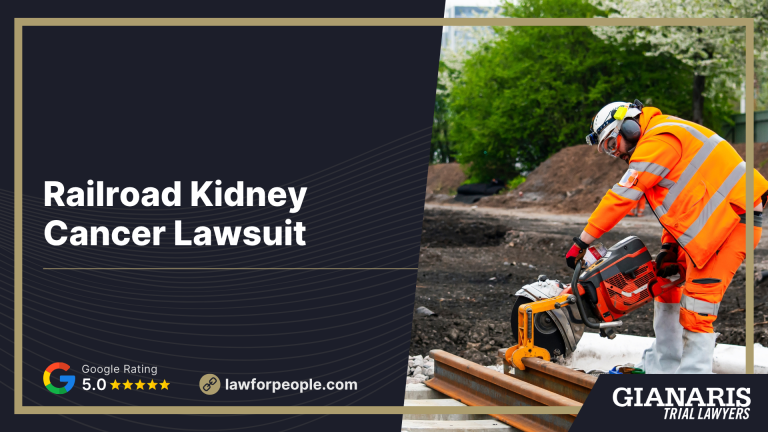Kidney cancer has become a growing concern for railroad workers who were regularly exposed to hazardous substances throughout their careers.
The railroad industry historically relied on materials and operations that released toxic chemicals such as diesel exhaust, benzene, and solvents: all of which have been linked to an increased risk of various cancers, including kidney cancer.
Prolonged exposure to these carcinogens in confined work environments may damage cellular structures and kidney function over time, eventually leading to a cancer diagnosis.
Many former railroad workers, including sheet metal workers, engineers, conductors, and yard personnel, may be eligible to file lawsuits alleging that their employers failed to protect them from these workplace hazards.
These claims are often filed under the Federal Employers Liability Act (FELA), which provides legal avenues for injured or ill railroad workers to pursue compensation.
If you or a loved one developed kidney cancer after working in the railroad industry, legal options may be available.
You may be entitled to compensation through a railroad cancer lawsuit.
Contact an experienced railroad cancer lawyer to learn more about your rights.
Scientific Research Supporting Kidney Cancer Claims in Railroad Workers
The most persuasive science in railroad kidney-cancer cases centers on trichloroethylene (TCE) and other chlorinated solvents historically used for parts-washing and degreasing, with additional support from mixed diesel exhaust constituents (PAHs, nitro-PAHs, metals) and legacy shop exposures.
Authoritative agencies classify TCE as a known human carcinogen with sufficient evidence for kidney cancer, and regulatory/industrial-hygiene materials document solvent toxicity, ventilation/PPE requirements, and medical surveillance—evidence that these hazards were both foreseeable and controllable in rail settings.
Diesel exhaust is the dominant lung cancer risk in rail cohorts; for kidney cancer, pooled and mechanistic evidence points most strongly to TCE/solvent pathways (with nephrotoxicity, genotoxic metabolites, and proximal tubular injury), which is why TCE and certain solvent mixtures are the primary exposure theories in kidney-cancer claims, while diesel particulate is used chiefly to characterize overall inhalation burden.
Studies and literature on kidney cancer and occupational exposures include:
- IARC Monographs (Vol. 106, 2014) – Trichloroethylene (TCE): Confirms Group 1 (carcinogenic to humans)with sufficient evidence for kidney cancer in humans, supported by animal and mechanistic data (nephrotoxicity, mutagenic metabolites). Use as the cornerstone classification for solvent exposures in rail shops.
- U.S. EPA IRIS (2011) – TCE Toxicological Review: Quantifies kidney-cancer risk, provides dose–response and PBPK modeling, and details biologic plausibility via glutathione-conjugation pathways in the renal proximal tubule.
- Meta-analyses of TCE & renal cell carcinoma (e.g., Environmental Health Perspectives / Occup. & Environ. Med.): Show exposure–response trends and elevated RCC risk among workers with moderate-to-high TCE exposure, strengthening causal inference beyond single studies.
- Chlorinated-solvent cohorts (degreasing/metalworking trades): Large case–control and cohort studies in solvent-intensive industries report increased RCC where cumulative TCE exposure was highest, supporting rail shop analogs (parts-washing, vapor degreasing, confined bays).
- IARC Monographs (Vol. 105, 2012) – Diesel Engine Exhaust: Classifies diesel exhaust as Group 1 for lung cancer; while kidney evidence is limited/inadequate, these cohorts document intense, chronic inhalation environments that co-occurred with solvent use, useful context for reconstructing total exposure.
- OSHA solvent and hazard-communication standards (29 CFR 1910): Require exposure monitoring, engineering controls, and training for chlorinated solvents; probative on notice and duty to protect where TCE and similar agents were used.
- U.S. railroad diesel cohorts (Garshick/Laden et al.): Demonstrate elevated mortality in diesel-exposed operating crafts and quantify historical exposure intensity, contextual evidence that supports cumulative inhalation burdens alongside solvent exposures in legacy rail eras.
These sources collectively underpin the theory that long-term solvent exposure (especially TCE) drives kidney-cancer risk in railroad environments, with diesel-rich atmospheres amplifying overall toxic load and supporting negligence and foreseeability arguments in FELA claims.
Railroad Jobs at Risk for Exposure to Dangerous Substances Linked to Kidney Cancer
Certain railroad roles placed workers at especially high risk of exposure to toxins linked to kidney cancer.
Jobs that involved close contact with diesel-powered equipment, chemical cleaners, or maintenance of railroad ties are now under scrutiny in active railroad cancer lawsuits.
Common positions that may be impacted include:
- Locomotive engineers and conductors
- Diesel mechanics and equipment operators
- Yardmasters and brakemen
- Track maintenance and bridge workers
- Sheet metal workers, pipefitters, and electricians
- Signal maintainers and welders
These roles often involved prolonged exposure to harmful substances in poorly ventilated or confined environments.
Railroad companies were often aware of these risks but failed to take adequate precautions — a factor that continues to drive railroad workers cancer lawsuit filings across the country.
Can I File a Wrongful Death Lawsuit if My Loved One Passed Away of Kidney Cancer?
Yes.
If your loved one passed away from kidney cancer and had a history of employment in the railroad industry, you may be able to file a wrongful death claim under the Federal Employers Liability Act (FELA).
These lawsuits allege that employers failed to protect workers from dangerous exposures, which ultimately contributed to their illness and death.
FELA allows surviving family members — such as spouses, children, or dependent relatives — to seek compensation for medical expenses, funeral costs, loss of companionship, and lost future earnings.
These cases often rely on employment records, expert medical testimony, and evidence of workplace exposures to link the cancer to occupational causes.
If your family is navigating a recent loss, an experienced railroad cancer lawyer can help you determine your eligibility and explain your options for filing a railroad cancer lawsuit.
You may be entitled to a portion of future railroad cancer settlement amounts.
Contact us today for a free case review.



